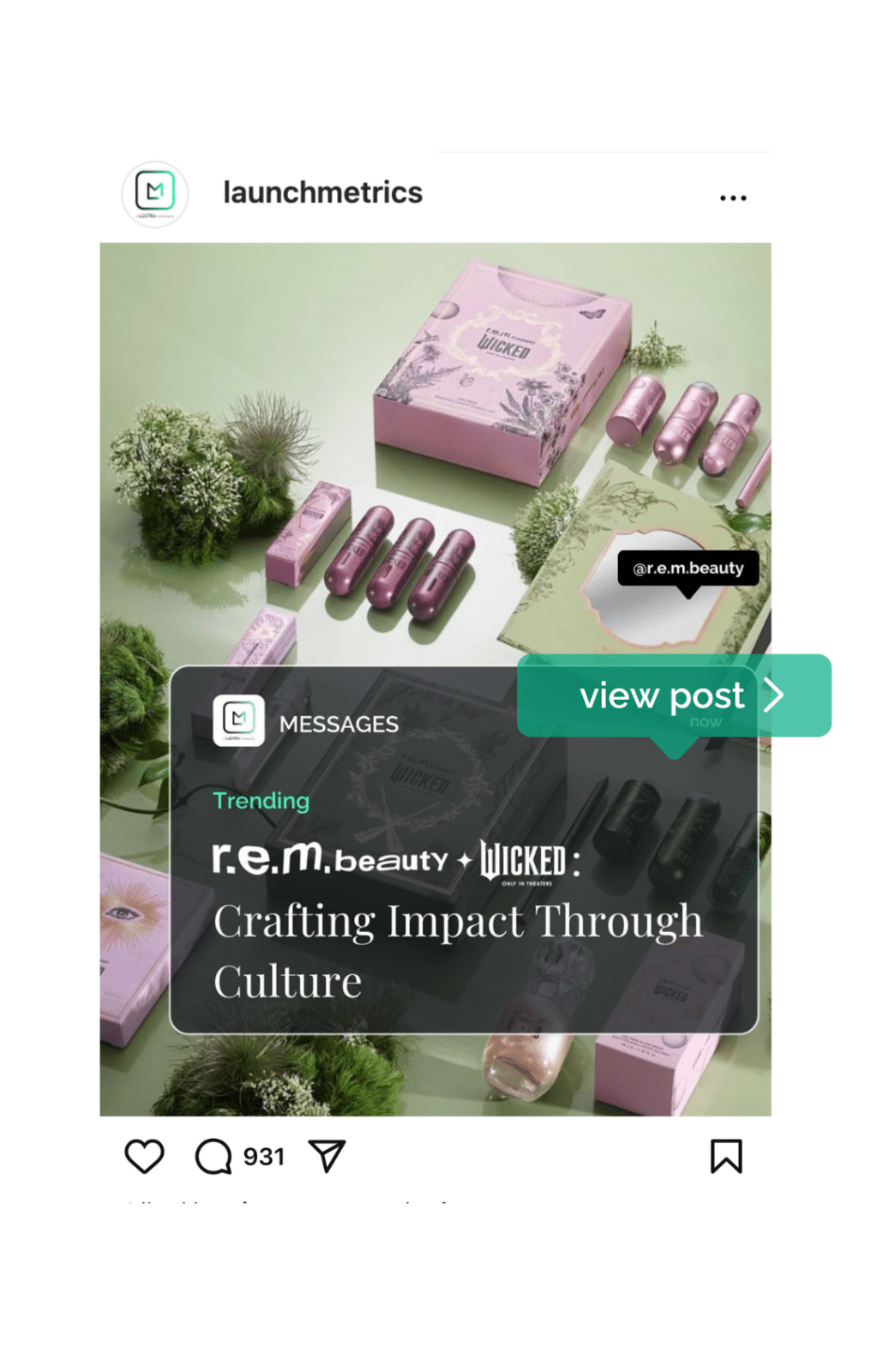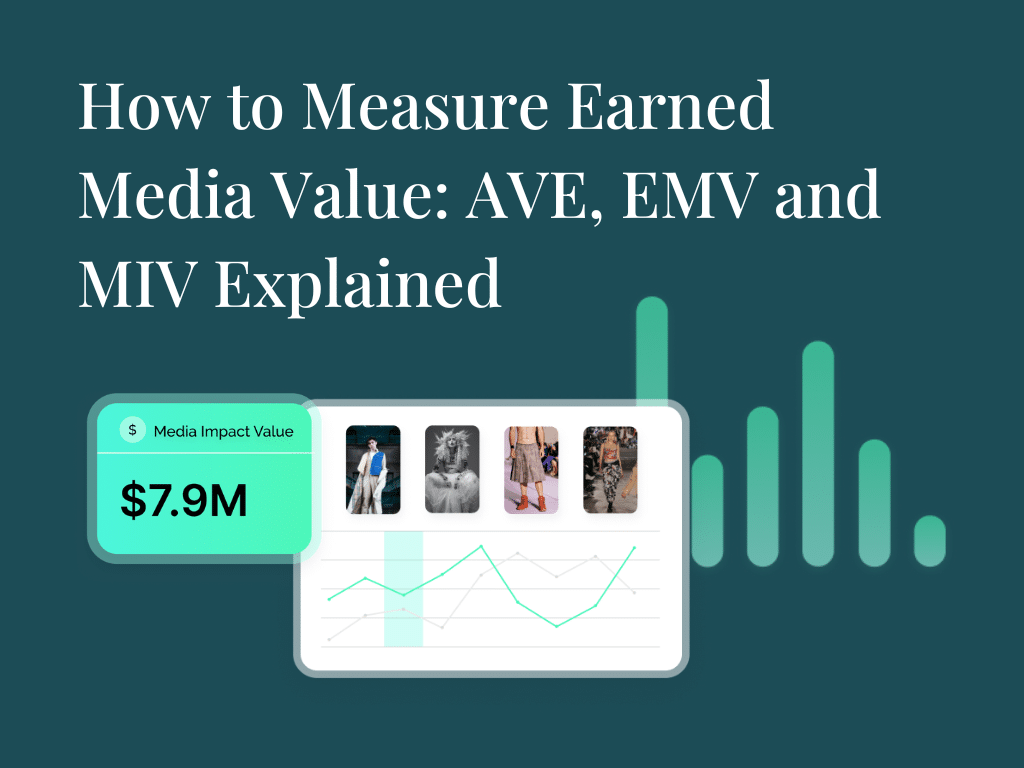At first glance, Earned Media Value (EMV) appears to be a useful metric for brands. It attempts to measure the impact of unpaid media exposure—an increasingly important activity in today’s world, where consumers are basing more of their purchasing decisions on word-of-mouth recommendations and endorsements from trusted sources.
However, measuring EMV isn’t a clear-cut process. “Brands tend to think of earned media as free, but in reality, there's a cost associated with it." says Arnaud Roy, Chief Strategy Officer at Launchmetrics, “You are paying for the coverage, even if it’s not a direct line item in your marketing budget.”
Because of this associated cost, marketing and PR departments need to calculate ROI to show how their investments perform. Metrics such as Advertising Value Equivalent (AVE) and Earned Media Value (EMV), while useful to a degree, have some major drawbacks. And in fact, there are other ways to gain a more holistic view of your brand’s performance.
In this post, we’ll take a deeper look at what EMV is and how to measure it, plus run through some other valuable metrics that can be used to gain deeper insights into your marketing efforts so you can optimize them for maximum impact.
In this article you’ll learn…
What is Earned Media?
Earned media refers to any publicity or exposure your brand gains organically, rather than through paid advertising or Owned channels. You can think of it as the natural conversations and coverage that happen when others choose to talk about your brand.
Earned media includes forms of publicity like news articles, blog posts, social media shares and customer reviews. That’s why we call this exposure “earned”—it comes about because a brand does something positive, transmits compelling stories or simply has a strong reputation, not because they’ve purchased advertising directly.
Here are a few earned media examples:
- Social media mentions: When customers tag your brand, use brand hashtags or share their experiences online.
- Press coverage: Articles, features or news stories published by media outlets.
- Influencer/Celebrity content: Posts by Influencer or Celebrity Voices featuring your brand without paid sponsorship.
- Word-of-mouth: Recommendations and positive reviews from customers.
- User-generated content (UGC): Photos, videos or posts created by your audience featuring your products.
Why is Earned Media Important?
Earned media is often viewed as more trustworthy and authentic because it comes from sources outside a brand’s control. If we look at Gen Z, ad tolerance has risen, but trust in advertising remains low. Instead, Influencer trust has grown, with 69% of consumers reporting more trust in influencers, friends and family over information coming directly from a brand.
Because of the declining trust in traditional advertising, earned media is more influential than ever when it comes to purchasing decisions. For brands, the question is how to measure the value of their earned media in order to understand brand sentiment, identify which channels and campaigns are best for generating organic engagement and optimize their earned media strategy.
How Do You Measure Earned Media?
Measuring earned media has always been a challenge for brands, even before the rise of digital platforms. In the pre-digital era, brands relied on manual methods like analyzing PR clippings to get a sense of their visibility and position in the market—but it wasn’t easy to quantify the actual impact on their business.
With the advent of digital media, brands could see exactly how many times their content was shared, who was talking about them online and what people were saying. This data has made things much easier for marketing and PR teams—though not without continuing challenges.
The Evolution of AVE to EMV
Historically, one of the earliest methods for valuing earned media was Advertising Value Equivalent (AVE). AVE attempted to assign a monetary value to earned media by estimating how much it would have cost to purchase the same space or airtime as an advertisement. While simple to calculate, AVE has been criticized for being overly simplistic and failing to account for the credibility and trust associated with earned media.
Earned Media Value (EMV) is more nuanced than AVE and was created to factor in aspects like engagement, reach and the quality of interactions. For instance, a highly shared social media post from a trusted Influencer can carry more weight than a static mention in a magazine. By incorporating these factors, EMV is supposed to provide a more accurate picture of how earned media contributes to a brand’s overall success.
However, EMV has some major limitations that brands need to be aware of. We’ll go into these below—for now, let’s look at how it’s commonly calculated.
How to Calculate Earned Media Value
Calculating EMV isn’t too difficult—you can even use a tool like an earned media value calculator. If you want to do it manually, here’s a basic formula for calculating EMV:
EMV = Reach × Cost Per Thousand (CPM) × Engagement Rate × Adjustment Factor
To calculate EMV, start by determining the reach of your earned media piece (like article views or social media impressions). Multiply this by the industry-standard CPM for that platform or channel, then factor in the engagement rate to reflect how many people actually interacted with the content. You can also apply an adjustment factor based on the content type and quality—for example, a detailed feature might use a higher multiplier (e.g., 5–8), while a brief mention might use a lower one (e.g., 1–2).
A strong EMV result would be several times higher than the amount spent on paid media.
Why EMV and AVE Are Becoming Less Popular
If we look at AVE, it’s clear that this method isn’t the best in the digital age. Long considered the standard for measuring editorial placements in print publications, it’s calculated by multiplying advertising rates by the page percentage an editorial placement covers. AVE then assigns a monetary amount for the value that a piece of coverage earned. This method is highly accurate for print placements, but the lack of standardized advertising rates for digital channels makes it difficult to calculate an accurate AVE for online and social media mentions.
That’s why many marketers turned to EMV as a way to calculate ROI for online and social media. Unfortunately, there is neither a standardized approach nor definitive criteria for calculating EMV. Methodologies are typically based on impressions and/or engagement; and while some companies leverage media rates, not everyone does—which is particularly risky. Assigning a dollar value without incorporating a baseline rate over-inflates the numbers and does not allow brands to correlate results back to actual marketing investments or business impact.
Additionally, AVE and EMV methodologies don’t always incorporate content quality when defining values, which can also over-inflate the numbers. Quality factors, such as image content, the number of brands mentioned and the number or type of hashtags, can significantly impact the overall value of coverage.
For example, posts with #giveaway typically have high levels of engagement, but it’s often the same people commenting multiple times as they tag different friends, which inflates engagement figures without necessarily driving meaningful brand connection or loyalty.
What to Use Instead: The Value of MIV®
Media Impact Value® (MIV®) is a proprietary metric that allows brands to quantify the impact of their marketing and communication activities in monetary terms. MIV is valuable because it’s much more comprehensive and accurate than EMV: While EMV simply multiplies reach by a flat advertising rate, MIV incorporates multiple weighted factors, including quality of placement, source credibility, content format, viewer engagement and market-specific variables. This multi-dimensional approach allows brands to understand not just the quantity but the true quality and effectiveness of their media coverage.
On top of this, it’s finely tuned to the specificities of the Fashion, Lifestyle and Beauty (FLB) industries—and is increasingly becoming one of the most prominent metrics in those fields. In our Holiday Marketing 2024 Report, 42% of FLB professionals said they plan to use MIV to measure the effectiveness of their campaigns.
If we recall the words of Arnaud Roy above, earned media isn’t really free. There’s always an associated cost with getting PR exposure. MIV allows brands to get a true sense of their return on investment for any marketing activity and the media mentions associated with it. Because it’s a standardized metric, you can directly compare, say, the value of an Influencer mention on TikTok with a gallery feature in an online magazine—something that’s not possible with EMV.

At a high level, we can see that r.e.m beauty’s Wicked collection generated $17M in MIV in 6 months. With MIV as our metric, we could also break this down into which Voices generated the most value on which platforms, in which markets, and more.
There are also other key metrics—which MIV encompasses—that can help measure the value of earned media, such as:
Share of Voice (SoV)
Share of Voice is an invaluable metric for competitive benchmarking. It measures how much media attention your brand gets compared to your competitors and helps you gauge your position in the market. When used in conjunction with MIV, it not only reveals your brand’s share of overall mentions but also quantifies the quality and monetary value of that coverage. For example, you might achieve a high MIV from a single Influencer mention, but if competitors are securing multiple mentions across top-tier outlets, your SOV will highlight this gap.
Voices
To evaluate your earned media coverage, it’s important to understand the different Voices that influence the customer journey and get a handle on which ones are working best for you. Is your most valuable brand exposure coming from Influencers? If so, which ones? Or is the Media your biggest advocate? Which outlets should you engage more with to capitalize on this coverage?
Again, it’s not just about which Voices are giving you the most mentions, but about which ones are giving you the most valuable mentions—and MIV is the most effective measurement for finding this out.
Summing Up…
So, as we’ve seen above, measuring the value of your earned media is a crucial activity if you want to strategically build your brand and optimize your marketing budget. EMV and AVE have historically been an approximate way to do this, however, they’re proving less reliable in today’s complex landscape. Instead, brands need to get a deeper, more holistic view of their marketing performance using metrics that allow them to truly gauge the ROI of every activity and media mention.
Click here to learn more about how to use MIV to track your PR and media mentions.
